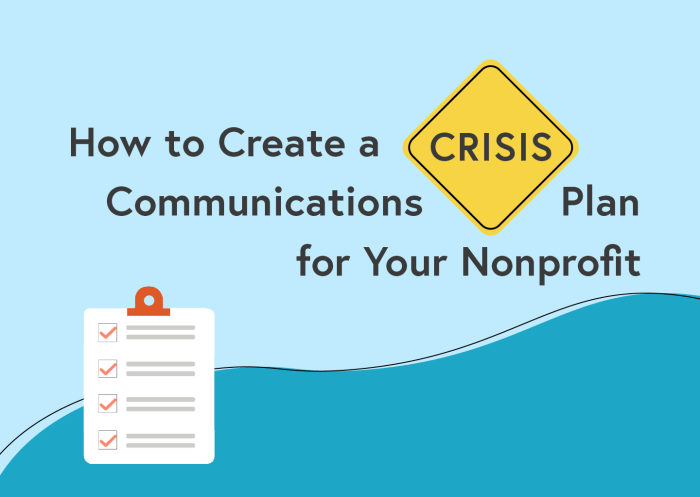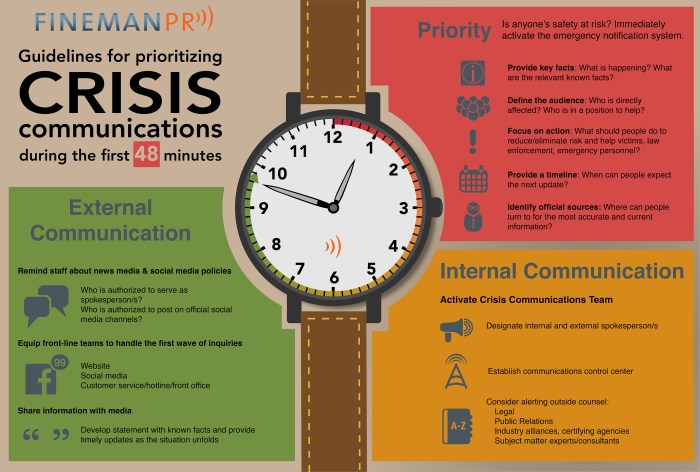Kicking off with Developing a Crisis Communications Plan, this opening paragraph is designed to captivate and engage the readers, setting the tone for a high school hip style that unfolds with each word. In today’s fast-paced world, having a solid crisis communications plan is essential for organizations to navigate through challenging times with grace and resilience. Let’s dive into the key components and strategies that can make all the difference when crisis strikes.
Importance of Crisis Communications Plan

In today’s fast-paced and interconnected world, having a crisis communications plan is essential for organizations to effectively navigate through challenging situations. When a crisis strikes, having a well-thought-out plan in place can make a significant difference in how the organization responds and recovers.
A crisis communications plan provides a roadmap for how to communicate with various stakeholders, including employees, customers, media, and the public, during times of crisis. It helps ensure that the organization’s messaging is consistent, timely, and transparent, which is crucial for maintaining trust and credibility.
Real-life Examples of Effective Crisis Communications
- In 2018, Starbucks faced backlash after an incident at one of its stores where two black men were arrested. The company’s CEO, Kevin Johnson, responded quickly with a public apology and announced plans for racial bias training for employees. This swift and transparent response helped Starbucks regain public trust and mitigate the damage to its reputation.
- During the 2010 BP oil spill crisis, the company’s CEO, Tony Hayward, faced criticism for his insensitive comments. BP later replaced Hayward with a new spokesperson who focused on empathy and accountability, leading to a more effective crisis response and improved public perception of the company.
Impact of Effective Crisis Communication Strategies
According to a study by Deloitte, organizations with effective crisis communication strategies are 75% more likely to maintain or improve their reputation following a crisis.
In a survey by PwC, 69% of executives reported that their organizations had experienced a crisis in the past five years, highlighting the importance of being prepared with a crisis communications plan.
Key Components of a Crisis Communications Plan

In a crisis communications plan, several key components are essential to ensure effective communication during challenging times.
Essential Elements of a Crisis Communications Plan
- Clear Chain of Command: Designate who will be responsible for communicating with the media, employees, and other stakeholders during a crisis.
- Messaging Framework: Develop key messages that align with the organization’s values and ensure consistency in communication.
- Media Relations Strategy: Artikel how to engage with the media and provide timely and accurate information.
- Internal Communication Plan: Establish how to keep employees informed and address their concerns during a crisis.
- Crisis Response Protocols: Define specific actions to be taken in different types of crises to ensure a swift and coordinated response.
Role of Key Stakeholders
- Senior Leadership: Provide guidance and support in developing the crisis communications plan.
- Communications Team: Execute the plan and ensure messaging is consistent and effective.
- Legal Counsel: Offer advice on legal implications of communication strategies during a crisis.
Structuring the Plan for Different Crises
- Natural Disasters: Include details on evacuation procedures, emergency contacts, and recovery efforts.
- Cybersecurity Breaches: Address data breach notifications, IT response protocols, and communication with affected parties.
- Product Recalls: Artikel steps for recall announcements, customer notifications, and reputation management.
Developing a Crisis Communications Team
When it comes to handling a crisis effectively, having a well-prepared crisis communications team is key. This team plays a crucial role in managing communication during challenging times, ensuring that the organization’s reputation is protected and stakeholders are informed.
Selecting and Training Team Members
- Choose team members based on their expertise, experience, and ability to remain calm under pressure.
- Provide comprehensive training on crisis communication protocols, including media relations, social media management, and message development.
- Conduct regular drills and simulations to prepare team members for different crisis scenarios.
Designated Spokespersons and Communication Channels
- Assign specific individuals as designated spokespersons to ensure a consistent and controlled message is delivered to the public and media.
- Establish clear communication channels within the team to facilitate quick decision-making and information sharing.
- Ensure that all team members are aware of their roles and responsibilities during a crisis.
Preparation for Various Crises
- Stay informed about potential risks and vulnerabilities that could lead to a crisis situation.
- Create predefined message templates for different types of crises to enable prompt and accurate communication.
- Regularly review and update the crisis communications plan to adapt to new challenges and emerging threats.
Crisis Communication Strategies: Developing A Crisis Communications Plan
When faced with a crisis, organizations must have effective communication strategies in place to manage the situation and maintain their reputation. Different approaches, such as proactive and reactive, can be employed based on the nature of the crisis.
Proactive Communication, Developing a Crisis Communications Plan
Proactive communication involves preparing in advance for potential crises and having strategies in place to address them swiftly. This approach includes regularly monitoring for potential issues, establishing clear communication channels, and providing timely updates to stakeholders. An example of successful proactive communication is how Starbucks handled the racial bias incident in one of its stores by issuing a public apology and implementing diversity training for employees.
Reactive Communication
Reactive communication, on the other hand, involves responding to a crisis as it unfolds. This approach requires quick decision-making and effective messaging to address the situation and mitigate its impact. One notable example of reactive communication is how Johnson & Johnson managed the Tylenol poisoning crisis by recalling products, cooperating with authorities, and reassuring the public through transparent communication.
Tailoring Communication Strategies
The nature and severity of a crisis will determine the most appropriate communication strategy to employ. For instance, a natural disaster may require a more empathetic and compassionate approach to reassure affected individuals, while a product recall may necessitate a more factual and transparent communication style to address consumer concerns. By understanding the specific needs of each crisis situation, organizations can tailor their communication strategies effectively.